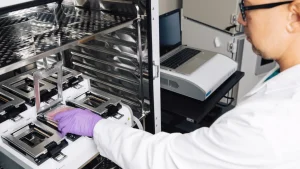Immune Cell Killing Assays
Typical immune cell killing assays are labor-intensive and require users to collect multiple timepoints using a combination of techniques. In contrast, the label-free xCELLigence RTCA instruments provide a complete view of immune cell killing and closely mimics activity in vivo. Obtain highly sensitive, reproducible, and direct measurements of immune cell killing potency in real time. This simple and high throughput workflow also provides greater insight into cellular mechanism of action, serial killing, and exhaustion.
Viral Cytopathic Effect Assays
Advance your anti-viral therapy or vaccine development by accurately measuring viral cytopathic effects (CPE) in real time with Agilent xCELLigence RTCA instruments, without the use of labor-intensive plaque assays. Monitor viral CPE automatically, from minutes to days, and greatly reduce workload and manual handling of samples. Measure cell proliferation kinetics, identify the optimal time point for viral infection with different cell seeding densities, and assess virus-mediated cytopathogenicity in one workflow.
Cytotoxicity Assays
Determine cytotoxic effects of drugs or compounds by monitoring cell proliferation, cell size or morphology, and cell-substrate attachment quality in real time. Monitor the kinetics of long-term cellular responses with this simple and high-throughput cytotoxicity assay. Make informed decisions about the timing of cell treatments and easily generate dose-response curves at multiple time points, without increasing the workload.
Cell Adhesion Assays
During tumor formation, primary cancers shed millions of cells into circulation, which are known as circulating tumor cells (CTCs). CTCs can re-attach, extravasate, and metastasize in distant organs. With xCELLigence RTCA, continuously monitor cell adhesion kinetics of different cell types to gain deeper insight into the intricacy of metastasis. Quantitatively assess cell attachment and spreading in real time, without the use of fluorescent reagents or dyes.
Cell Signaling Assays
G protein-coupled receptor (GPCR), receptor tyrosine kinase (RTK), or nuclear hormone-mediated signaling often results in biochemical changes that affect the number of cells present, the size/morphology of the cells, and how tightly the cells are interacting with the plate surface. With xCELLigence RTCA, you can sensitively capture changes in cell size, shape, and proliferation rate in response to cell signaling events. This label-free and continuous monitoring provides quantitative assessment of cell response in the initial minutes of exposure and their response over days.
Stem Cell Assays
Stem cell research provides mechanistic insights into disease, aids regenerative medicine development, and offers an alternative approach to test the liability and effectiveness of new drugs. Overcome cell therapy manufacturing challenges by predicting functional capacity and assessing variability of mesenchymal stem cells (MSCs) with xCELLigence RTCA. Maximize production yields using fewer cells and continuously measure integrated changes in cell number, attachment, and morphology to ensure consistency between passages.
Cell Barrier Function Assays
Cell barrier function, provided by endothelial and epithelial cells, can become compromised in many disease states. Endothelial cells line the interior surface of blood vessels and lymphatic vessels. Epithelial cells form the surfaces of the body that serve as a barrier to protect from foreign molecules. The impedance-based xCELLigence RTCA assay is a sensitive and quantitative alternative to the traditional methods to measure barrier disruption, including the solute permeability assay and transendothelial electrical resistance (TEER) assay.
 The Agilent xCELLigence Real-Time Cell Analysis (RTCA) MP instrument uses label-free cellular impedance to continuously monitor cell health, behavior, and function with high accuracy, sensitivity, and reproducibility.
The Agilent xCELLigence Real-Time Cell Analysis (RTCA) MP instrument uses label-free cellular impedance to continuously monitor cell health, behavior, and function with high accuracy, sensitivity, and reproducibility.